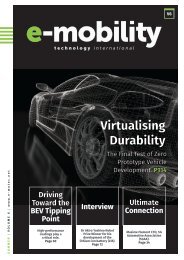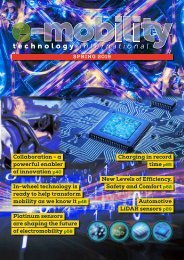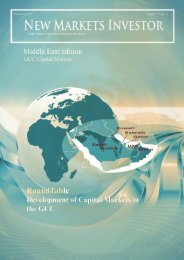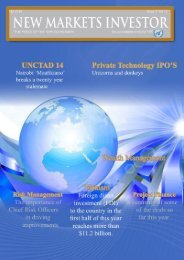E-mobility Technology Winter 2020
Electric vehicle technology news: Maintaining the flow of information for the e-mobility technology sector
Electric vehicle technology news: Maintaining the flow of information for the e-mobility technology sector
Create successful ePaper yourself
Turn your PDF publications into a flip-book with our unique Google optimized e-Paper software.
e-<strong>mobility</strong> <strong>Technology</strong> International | Vol 7 | <strong>Winter</strong> <strong>2020</strong><br />
5G boosts<br />
benefits for connected vehicles<br />
The introduction of 5G New Radio (based on 3GPP<br />
Release 15 specification) enables higher data rates<br />
and lower latencies for V2N network communications.<br />
The first deployments in commercial vehicles are<br />
expected to start as early as 2021. The following 5G<br />
phase (3GPP Release 16), expected to happen from<br />
2023 onwards, will provide even lower latency and<br />
high reliability to support V2V (Vehicle-to-vehicle) and<br />
V2I (Vehicle to Infrastructure) type communication,<br />
often referred to as 5G-V2X.<br />
This offers key features that support higher levels of<br />
cooperative automated driving. A recent 5GAA white<br />
paper looked at the new functions it makes possible,<br />
including areas such sharing sensor data, such as<br />
video from the car in front; control information to<br />
allow vehicles to drive in close formation, saving road<br />
space; exchanging vehicle trajectories to prevent<br />
collisions and protecting vulnerable road users like<br />
pedestrians and cyclists. These advanced examples of<br />
V2V and V2I communications are clearly only feasible<br />
thanks to 5G technology. Although the physical radio<br />
layers of LTE releases and 5G NR are very different, the<br />
chipsets and associated communication stacks will<br />
integrate the different radio technologies, supporting<br />
smooth operation and backward compatibility of<br />
services.<br />
Nokia has played key role in these connected vehicle<br />
test projects focused on the verification of 5G based<br />
new network capabilities and Multi-access Edge<br />
Computing (MEC) to support the advanced needs of<br />
automotive related use cases. The first MEC based use<br />
cases was held in 2015 with Deutsche Telekom at the<br />
National German test bed motorway A9 with partners<br />
Continental and Fraunhofer. Since then tests have<br />
been extended to more complex use cases in various<br />
countries with other partners around the globe<br />
such as in Japan, China and Germany. The ongoing<br />
EU funded projects such as 5G Carmen includes the<br />
analysis and verification of functions distributed<br />
between edge clouds deployed in networks of<br />
different operators even across borders. In the MEC-<br />
VIEW project Edge computing is used to complement<br />
local information generated by sensors in the vehicle<br />
with information generated by road side cameras<br />
with the objective to support automated driving in<br />
challenging urban situations.<br />
5G technology elements have been in the focus of<br />
other projects like the EU financed 5GCar focused<br />
on testing coordinated lane merge, the cooperative<br />
perception of connected vehicles and protection of<br />
vulnerable road users. Nokia, together with Seat,<br />
Telefonica, FICOSA and other partners also tested<br />
Vulnerable road discovery in Segoviav – utilizing<br />
MEC. The 5G NetMobil project included the use of<br />
network slicing technology to support different<br />
Quality of Service (QoS) requirements when vehicles<br />
use communication infotainment and safety critical<br />
applications in parallel. Nokia has also supported<br />
SoftBank with the construction of a 5G verification<br />
environment for connected vehicles at Honda<br />
Research and Development site in Japan.<br />
With several industries on board, driven by the<br />
telecom and automotive industries, the connected<br />
car is really going places. However, the global<br />
commercialisation of connected automated driving<br />
will not only depend on the successful verification<br />
and introduction of technologies in networks,<br />
vehicles and road infrastructure. New business and<br />
cooperation models between the ecosystem partners<br />
will have to be developed and complemented with<br />
the evolution of the regulatory framework related<br />
to driving, data handling and management. This is<br />
an industry challenge that we will solve by working<br />
closely and collaboratively with our ecosystem<br />
partners.<br />
Uwe Pützschler, Head of Automotive & Mobility<br />
Solutions, Nokia and Vice-Chair of the 5G<br />
Automotive Association<br />
e-<strong>mobility</strong> <strong>Technology</strong> International | | www.e-motec.net<br />
11









